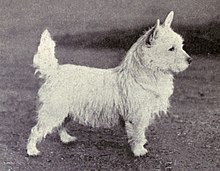West Highland White Terrier
It has a white double coat of fur which fills out the dog's face, giving it a rounded appearance.It is an energetic, boisterous, and social breed with a high prey drive, having been bred to hunt small rodents at places such as farms, and needs regular exercise of around one hour per day.[2] Members of the breed typically weigh between 15 and 20 pounds (6.8 and 9.1 kg) with an average height between 10–11 inches (25–28 cm) at the withers.[2] Westies have a deep chest, muscular limbs, a black nose, and a short closely-fitted jaw with "scissors" bite (lower canines locked in front of upper canines, upper incisors locked over lower incisors).[4] Young puppies have pink markings on the nose and footpads that slowly turn black as they age.[citation needed] Westies have a rough outer coat that can grow to about 2 inches (5.1 cm) long[3] and a soft, dense, thick undercoat.[citation needed] They will not typically tolerate rough handling, such as a child pulling on their ears or fur, and can frequently be both food- and toy-possessive.They are loyal and bond with their owner but are often on the move, requiring daily exercise of at least 15–30 minutes, although an hour is the recommended minimum.[3] About one quarter of Westies surveyed are affected by atopic dermatitis, a heritable chronic allergic skin condition.[14] An uncommon but severe breed-specific skin condition, hyperplastic dermatosis, may affect West Highland White Terriers of any age.[17] Other less common conditions which appear in the breed include hydroxyglutaric aciduria, which is where elevated levels of Alpha-Hydroxyglutaric acid are in the dog's urine, blood plasma, and spinal fluid.Symptoms involve generalised and serious patches of alopecia, erythema, lichenification, hyperpigmentation, malodor, otitis externa, and pruritus.[23][24] A 2021 British study looking at clinical records found predispositions to chronic hepatitis and hepatocellular death, caused by either toxins or acute liver failure; compared to other dogs, Westies are 3.23 times more likely to contract chronic hepatitis and 3.87 times more likely to contract hepatocelluar death.The king ordered that a dozen of these white terriers be procured from Argyll to be presented to the Kingdom of France as a gift.[30] The dog seemed to produce these white puppies regardless of the sire to which she was bred, and after drowning over 20 of these offspring, he came upon the theory that it was an ancient trait of the Scottish Terrier that was trying to reappear.Flaxman is credited with classes being added to dog shows for white Scottish Terriers towards the end of the 19th century.[31] The person most closely associated with developing the modern breed of West Highland White Terrier is Edward Donald Malcolm, 16th Laird of Poltalloch.By the time of Malcolm's death in 1930, a stable type had appeared with prick ears, a white coat, and a short back.Because the breed was not yet recognised independently, the championship title was not retained when the dog was reregistered as a West Highland White Terrier.






ScotlandThe Kennel ClubFédération Cynologique Internationaledomestic dogbreed of dogterrierCairn TerrierCruft'sWestie jawundercoatouter coatwithersScottish DeerhoundStanley CorenThe Intelligence of Dogscrossbreedsherniascraniomandibular osteopathyautosomal recessiveGreat DaneRadiographic testingatopic dermatitishyperpigmentationlichenificationalopeciagloboid cell leukodystrophyBeaglesPomeraniansgalactosylceramidasewhite dog shaker syndromeMalteseYorkshire TerrierDachshundhypermetriaAlpha-Hydroxyglutaric acidataxiaStaffordshire Bull TerriersLegg–Calvé–Perthes syndromeAustralian ShepherdMiniature Pincherluxating patellaseborrhoeic dermatitisMalasseziaerythemamalodorotitis externaprurituschronic hepatitisJames VI of ScotlandArgyllKingdom of FranceScottish TerrierSpanish ArmadaClan DonaldClan MacLeodChiefsNorman MacLeodGeorge Campbell, 8th Duke of ArgyllClan CampbellNiall Campbell, 10th Duke of ArgyllCountess of AberdeenKennel ClubCruftsAmerican Kennel ClubCanadian Kennel Clubpedigreesconformation showsWestminster Kennel Club Dog ShowBurneze Geordie GirlguineasGoogle BooksManchester Evening NewsHodder & StoughtonTerriersWorking breedsAiredale TerrierBedlington TerrierBorder TerrierCa Rater MallorquíChilean TerrierIrish TerrierJagdterrierKerry Blue TerrierLakeland TerrierManchester TerrierOld English TerrierParson Russell TerrierPatterdale TerrierPlummer TerrierRatonero Bodeguero AndaluzRatonero MurcianoSmooth Fox TerrierSoft-coated Wheaten TerrierTerrier BrasileiroValencian TerrierVillanuco de Las EncartacionesWelsh TerrierWire Fox TerrierPinschersAffenpinscherAustrian PinscherDanish–Swedish FarmdogDobermannGerman PinscherMiniature PinscherSchnauzersGiant SchnauzerMiniature SchnauzerStandard SchnauzerBlack Russian TerrierDutch SmoushondAustralian TerrierCesky TerrierDandie Dinmont TerrierGlen of Imaal TerrierJack Russell TerrierJapanese TerrierMiniature Fox TerrierNorfolk TerrierNorwich TerrierRat TerrierSealyham TerrierSkye TerrierSporting Lucas TerrierTeddy Roosevelt TerrierTenterfield Terrier